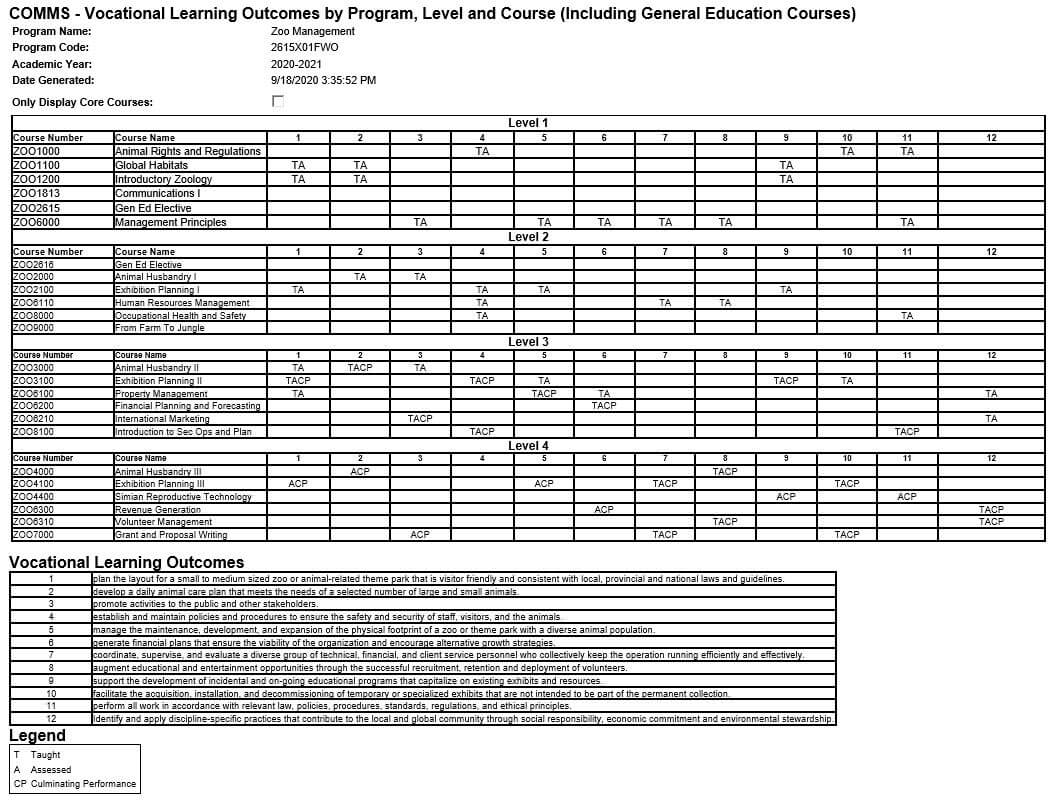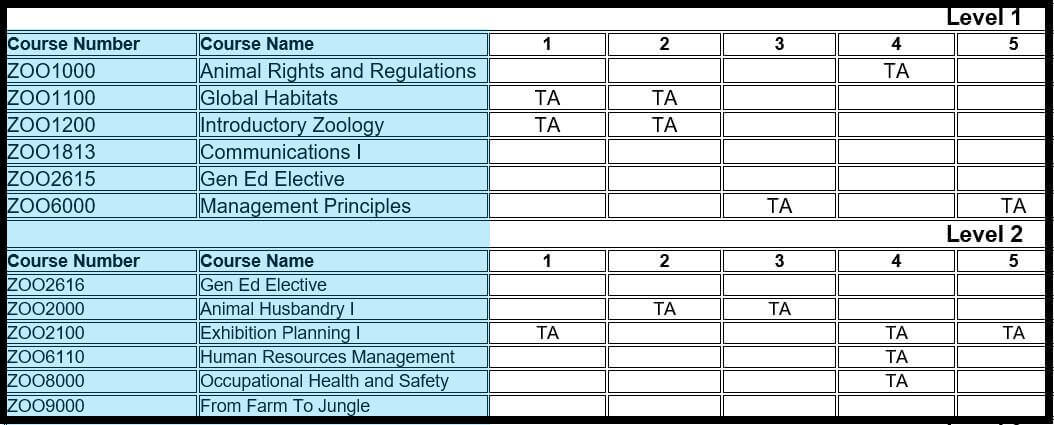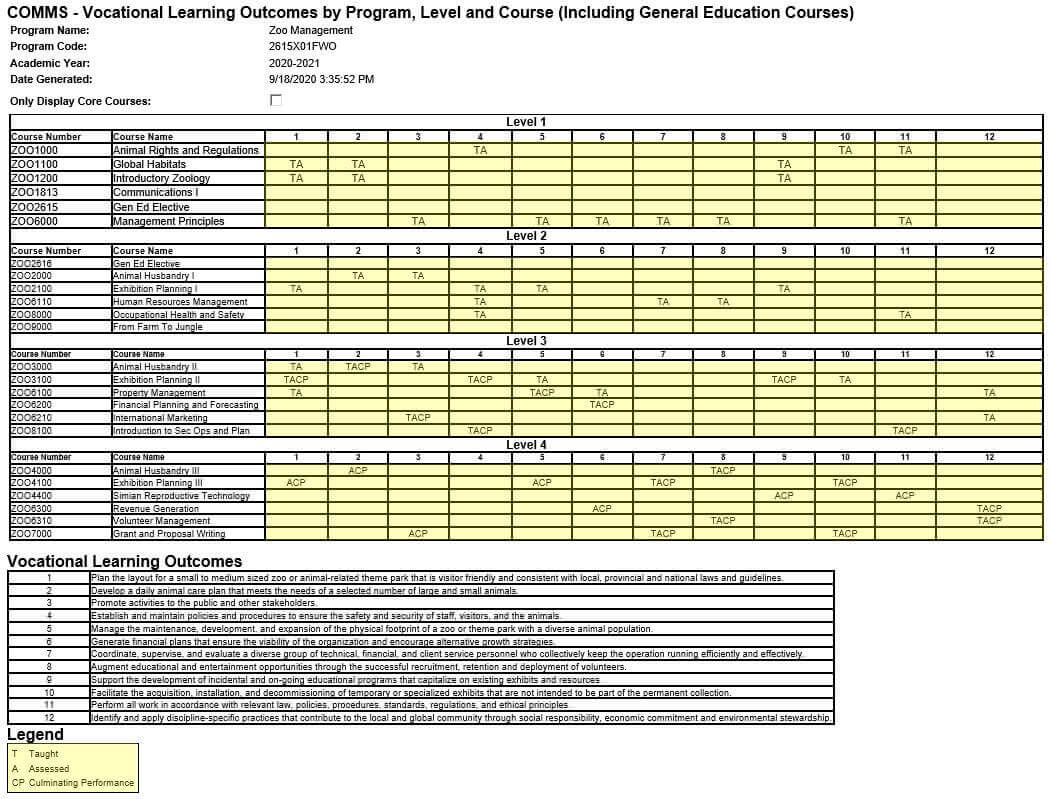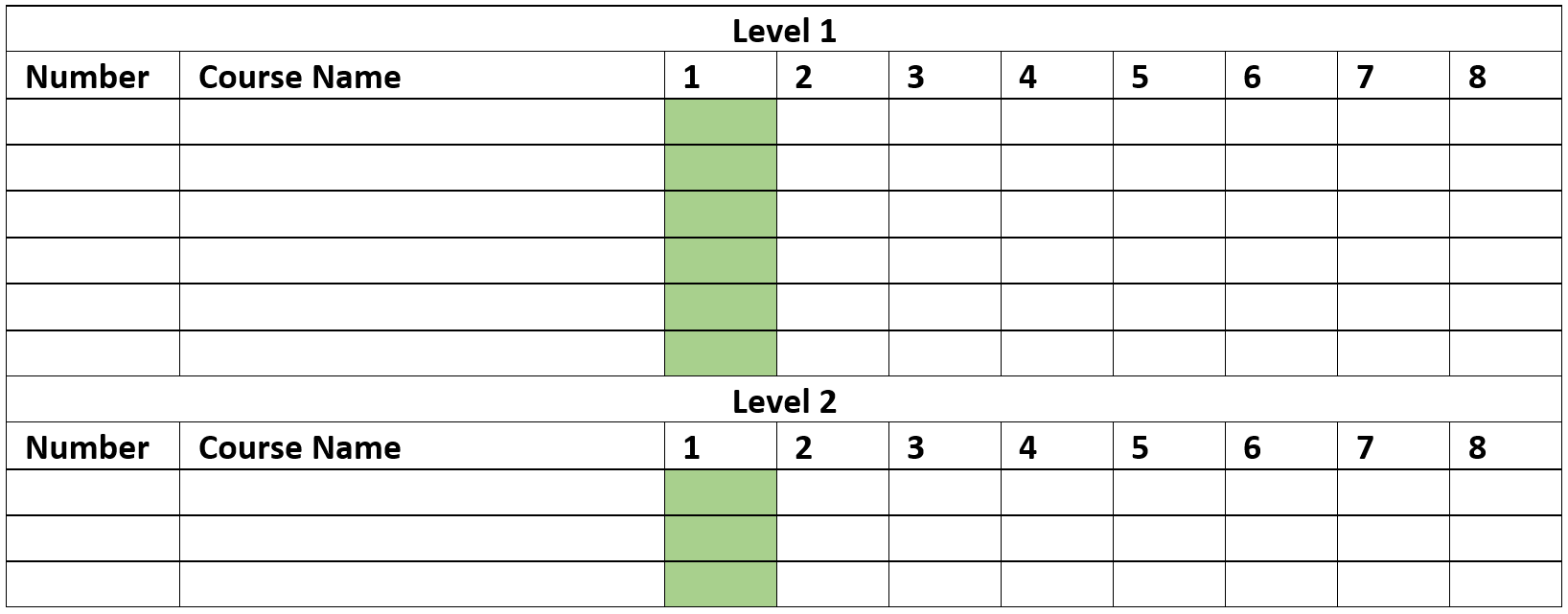Program Outcome Mapping
What is Program Outcome Mapping?
Program outcome mapping is the process of documenting and analyzing the structure of a program. Its purpose is to communicate how courses work together to support learners in developing knowledge, skills and attitudes towards the Vocational Learning Outcomes (VLOs), Program Learning Outcomes (PLOs), or Essential Employability Skills (EESs)*. Program outcome maps, such as VLO, PLO, and EES maps, serve as the link between the courses in a program and the program-level learning outcomes.
Curriculum maps have several purposes:
- To provide a visual representation of the program from a bird’s-eye-view.
- To communicate to students, faculty, administrators and external stakeholders how program-level learning outcomes are achieved within a program.
- To verify that students have opportunities to learn fundamental knowledge, skills and abilities before approaching advanced outcomes and then graduate-level outcomes.
- To serve as a review tool to analyze sufficient coverage of program-level learning outcomes.
- To verify individual course contribution towards students’ achievement of program-level learning outcomes.
- To foster faculty discussion and coordination of program curriculum through regular collaborative review.
Anatomy of Program Outcome Maps
At Algonquin College, program outcome map information is stored in COMMS (Course Outline Mapping and Management System). Program outcome maps can be produced for either Vocational Learning Outcomes (VLOs), Program Learning Outcomes (PLOs), or Essential Employability Skills (EES) from COMMS in the following format. There are several sections common to all program outcome maps as described below.

Program Information
The heading section identifies the Program Name, Program Code, Academic Year and Date Generated for the curriculum map. There is also a button to indicate whether the map includes all courses or only core courses (core courses are non-elective courses).

Course Information
The first two columns of the curriculum map list the program courses by course number and course name. They are organized by Level.

Program-Level Learning Outcomes (Vocational Learning Outcomes or Essential Employability Skills)
Columns to the right of the course information columns are labeled with numbers that correspond to the program-level learning outcomes (VLOs, PLOs, or EES). These outcomes are listed in full below the curriculum map table.

Program Outcome Mapping
The curriculum is mapped with letter codes (T, A, CP) which represent which courses contribute towards the achievement of each program-level learning outcome (VLO, PLO, or EES). The letters are defined in a Legend below the curriculum map table. T represents Taught; A represents Assessed; CP represents Culminating Performance.

Teach, Assess, Culminating Performance
The role each course plays in contributing towards the program-level learning outcomes (VLOs, PLOs, and EESs) is indicated with Teach (T), Assess (A) and/or Culminating Performance (CP) which hold specific meaning in this context.
Teach (T) – Significant amount of time devoted to developing skills and knowledge embedded in the VLO/PLO/EES
- Do you provide significant instruction/learning opportunities for this skill in your course?
- Do you devote a significant amount of time to facilitating student development of the skills and knowledge embedded in the program-level learning outcome?
- Is this program-level learning outcome reflected in one or more Course Learning Requirements?
Assess (A) – Significant component of VLO/PLO/EES is evaluated through student assessment
- Are there assignments, tests or projects which are designed to allow you to evaluate or assess student performance towards this program-level learning outcome or some of its elements?
- Do you, in your evaluation of student performance, verify that student performance is progressing towards this particular program-level learning outcome (or a significant component of it)?
- Is this program-level learning outcome reflected in one or more Course Learning Requirements?
- Is this program-level learning outcome reflected in the evaluation section of the course outline?
Culminating Performance (CP) – Student performance demonstrates integration of knowledge and skill of entire VLO/PLO/EES at the level appropriate to the credential and entry into industry
- Is there an opportunity for you to evaluate the program-level learning outcome in its totality at the level expected of a graduate?
- Does the evaluation result in a final product or performance which allows you to determine whether the learner has integrated the knowledge and skills identified in the program-level learning outcome?
- Can you determine from this performance if the learner has demonstrated achievement of the program-level learning outcome?
- Is this program-level learning outcome reflected in one or more Course Learning Requirements?
- Is this program-level learning outcome reflected in the evaluation section of the course outline?
Locating Program Outcome Maps
Program outcome maps are stored in COMMS (Course Outline and Mapping Management System) which can be accessed with your College username and password. Use the following guide to locate a program outcome map.
Reviewing Program Outcome Maps
Looking at each column, examine the representation and progression of each Vocational Learning Outcomes (VLO).
- Are there instances of Teach (T), Assess (A) and Culminating Performance (CP) for each column/VLO?
- Are there two culminating performances (CP)?
- Is each VLO taught (T) before or concurrently with the first time it is assessed (A)?
- Is each VLO taught (T) and assessed (A) before or concurrently with the first culminating performance (CP)? There should be no more instances of teaching (T) in any levels that follow a culminating performance (CP).
- Is the weight on VLOs appropriate given the focus of the program and current industry needs? Some VLOs may be more central to the program than others, leading to a heavier representation on the map.

Looking at each row, examine the balance of the Vocation Learning Outcomes (VLOs) mapped to each course.
Are there any courses that appear to be unbalanced?
- Some courses may have a heavier load such as survey, capstone or field courses.
- Some courses may have a lighter load such as specialized courses.
- Some courses may not map to any VLOs if they serve another purpose in the program such as supporting the development of Essential Employability Skills (EESs) or the General Education (GenEd) requirement. If a course does not support VLOs, EESs or GenEd, the role of the course in the program must be reevaluated.
Essential Employability Skills Mapping
For programs responsible for Essential Employability Skills (EESs), the process for reviewing an EES map is the same as a Vocational Learning Outcome (VLO) map.
The Essential Employability Skills are common across different credentials, and each course can only have one EES mapping. This can create challenges when mapping courses shared across different programs to EESs. Collaboration in the identification of the EES for a shared course can minimize the challenges.
The Essential Employability Skills website provides examples of teaching and assessing EES which can inform the review of EES maps
Mapping FAQs
1. Why does there need to be two culminating performances per program-level learning outcome (VLO, PLO, or EES)?
All sets of Vocational Learning Outcomes complete the following the following phrase: “the graduate has reliably demonstrated the ability to”. Including two culminating performances in a program allows students to “reliably” demonstrate their abilities through more than one performance and context. Culminating performances are significant assessments, so avoid more than two culminating performances for each program-level learning outcome where possible.
2. How many courses need to be mapped to each VLO, PLO, or EES? (How many T, A and/or CP should appear in each column?)
There is no specific number of T, A and/or CP required for each column, though every VLO/EES must have two CPs. The number of courses mapped to each VLO or EES varies based on the length of the program, the number of courses in the program and the number of VLOs as well as the level of affinity the VLO has to the program overall and the focus of the program. The courses mapped to each program-level learning outcome should be enough to allow progression of student learning towards the achievement of the outcome.
3. Do culminating performances have to be in the last semester of the program?
Culminating performances are an opportunity for students to demonstrate the achievement of the program-level learning outcome at the level appropriate for entry into industry, which students are typically prepared to do towards the end of a program.
4. Why should there not be additional instances of teach (T) after a culminating performance (CP) in the case the CP is not in the last semester of the program?
Before students attempt a culminating performance, they should be equipped with all of the knowledge, skills and attitudes required to demonstrate achievement of the program-level learning outcome in its entirety. As a result, there should be no teaching of new knowledge, skill or attitudes at any level following the first culminating performance. However, students may apply the learning outcome to new situations, in which case, it is appropriate reflect this in the program outcome map as an assessment (A).
5. How many VLOs, PLOs, or EESs should each course be mapped to? (How many T, A and/or CP should appear in each row?)
There is no specific number of T, A and/or CP required for each row. The number of VLOs or EESs that a course will map to varies based on the length of the program, the number of courses in the program and the number of VLOs as well as the level of affinity the course has to the VLOs and the type of course. For example, a survey course or a capstone course may support many program-level outcomes while specialized courses may map more lightly. The number should reflect the knowledge and skills that can reasonably be achieved by the end of the course, while ensuring reasonable coverage of program-level learning outcomes across the program, in order to support a reasonable student workload within each course.
6. If a course is only responsible for teaching (T), why must the corresponding Course Learning Requirement (CLR) be mapped to the assessments in the Evaluation and Earning Credit section of the course outline?
Within a course, anything that is taught is assessed to validate learning; each CLR is taught, so each CLR must also be assessed. However, the assessment may not be a significant assessment of the Vocational Learning Outcome as a whole as it may be at an introductory level. Each course has a role in the program as a whole but also has more specific/narrow course goals that need to be assessed to earn credit for the course.
7. Why are there inaccuracies in some of the Employability Skills maps?
The Essential Employability Skills are common across different credentials, and each course can only have one EES mapping. This can create challenges when mapping courses shared across different programs to EESs. Collaboration in the identification of the EES for a shared course is advisable if there are any concerns.